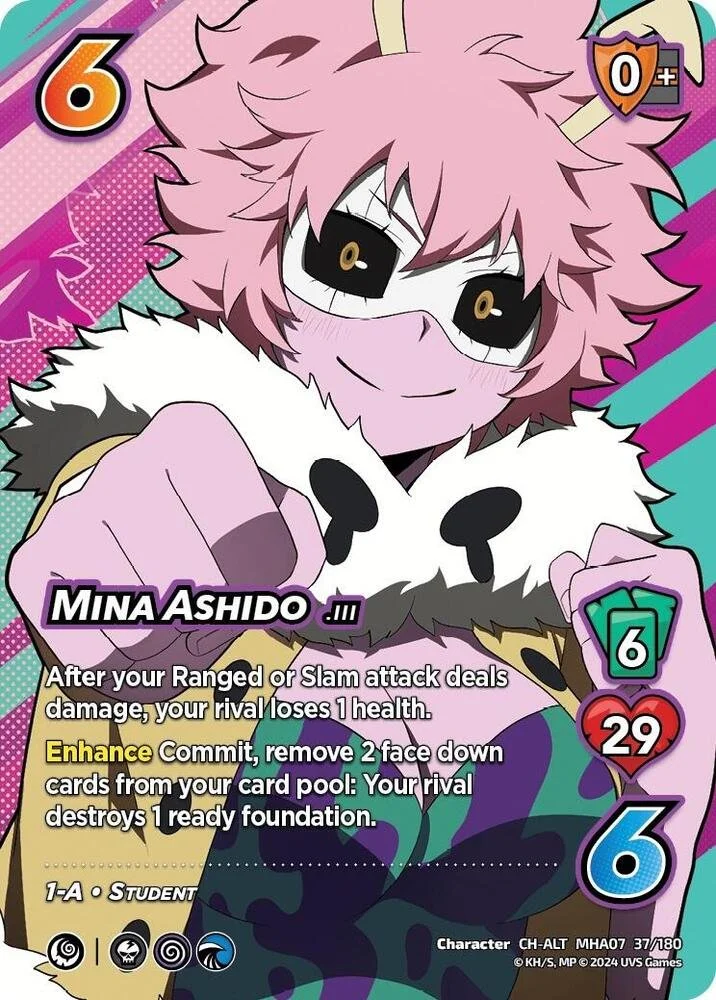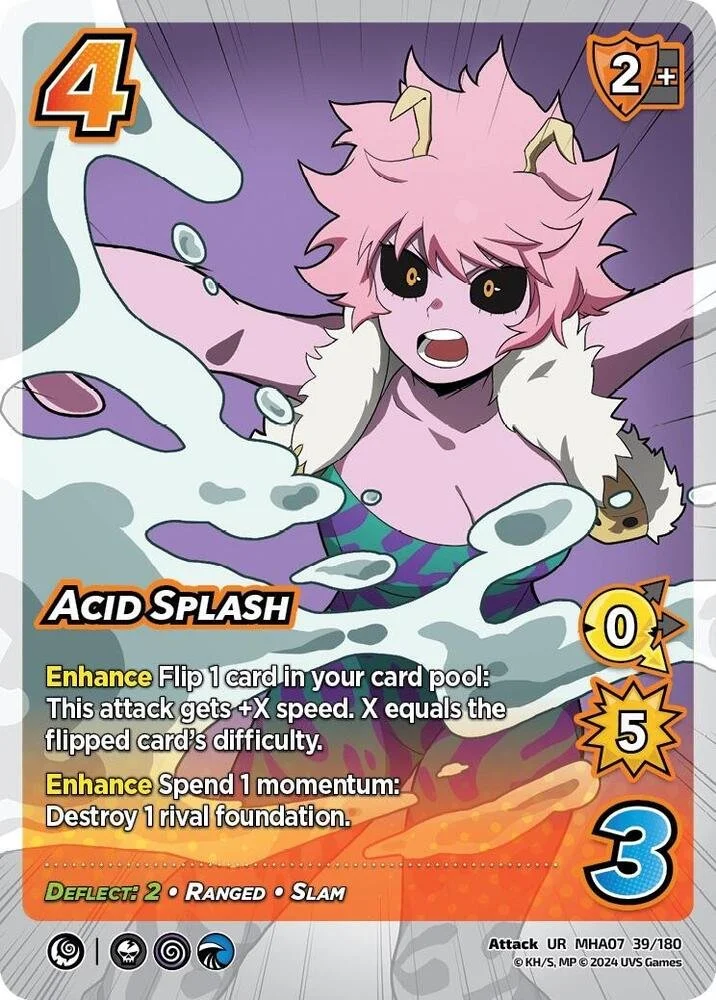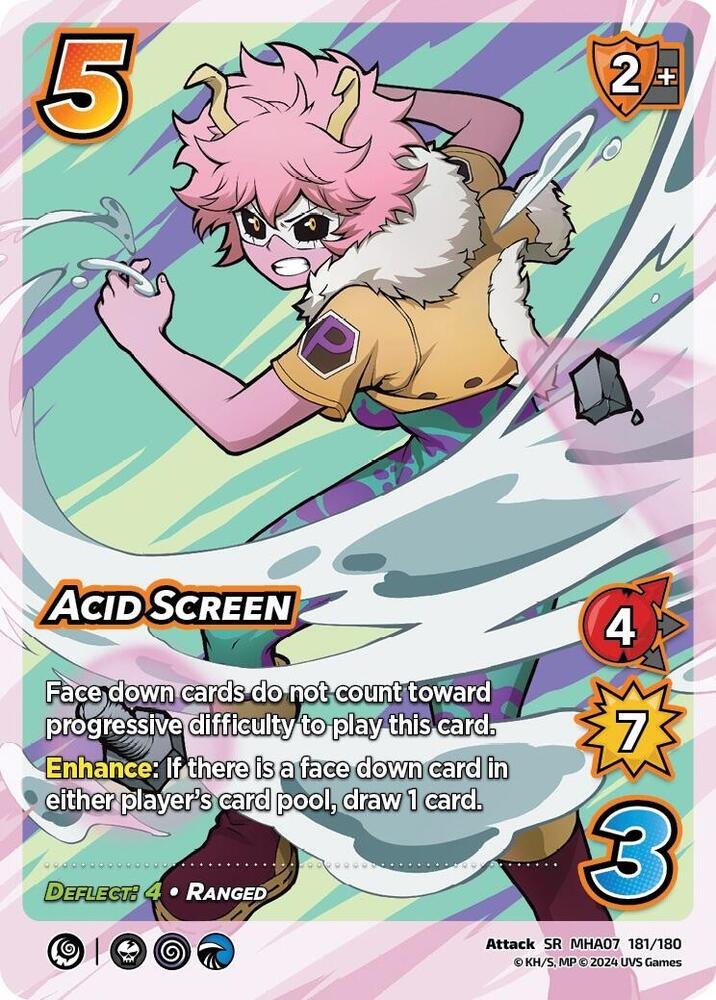... So, You Built a Terrible Deck for Locals
When we’re in between Regionals and serious competition, there’s this sweet spot where everything feels wide open. We start brewing again. Not because we think we’re going to break the format, but because we want to try something different. Something fun. Something that helps us avoid burnout, even if it doesn’t win.
I built Mina Ashido III on Death. Ranged package. Just vibes.
It didn’t win. Not even close. I made deck building mistakes (Charring Flurry? Momentum? WHAT WAS I THINKING AHHHHHHH) and many other non-bo’s.
Check out the decklist here, and you’ll notice the symbol was changed from “Death” to “Barf” in the title, which honestly feels like the most accurate summary of my feelings.
But really, this is why locals matter for deckbuilding.
Locals give you the space to be weird. You can run three copies of a card you'd never justify in a real deck. You can try a combo that makes no sense. You can walk in and say, I’m about to play a beautiful dumpster fire, and nobody’s going to chase you out of the building for throwing. It’s the one time you can chuck something at the wall and see what sticks.
That being said, sometimes it becomes clear, preeeetty fast, that you built a pile of… compost.
You get halfway through round two and realize your win condition was more of a theory than an actual plan. Your attack lineup has good intentions, but folds the second someone decides to block. Your sideboard looks like you panicked during a draft, but that does not mean it was a waste of time!
Why building a terrible deck is still worth it
You figure out what doesn’t work
Trying and failing is still trying. You walk away with real information. Maybe your deck blocked well, but never threatened damage. Maybe your foundation base was solid, but didn’t support the plan. You learn more from swinging and missing than from watching someone else hit the target.
So why did I play Mina III? I wanted to see how Acid Screen and Acid Splash felt in case I wanted to jam some Bebop in the TMNT release. Acid Screen felt solid. Acid Splash, not so much. It didn’t play well in a deck that didn’t want to generate momentum in the first place. But at least now I know. If it ever comes up again, I’ve got real reps with Acid Splash.
(It probably won’t ever come up again, I hate that card now, but still)
You shake up your habits
When you stick to meta decks for too long, you start thinking in patterns. You evaluate every card based on whether it fits inside a proven shell. You start shaving off anything that feels too risky or too weird because you’re optimizing instead of exploring. That’s fine when you’re preparing for a tournament, but it can start to choke out your creativity if you never step outside that space.
Brewing something intentionally off-meta forces you to break those habits. You stop asking, “What’s the best card in the format?” and start asking, “What can I do with this card?” You begin to see value in weird string lines, underplayed keywords, or strange interactions that would normally get filtered out by the meta checklist.
It also keeps your brain fresh. When you brew something off-kilter, you’re not just deckbuilding. You’re problem-solving. You’re thinking through different sequencing, weird foundations, and awkward kill conditions. Even if the deck doesn’t hold up, the practice of thinking differently carries over. Your serious builds benefit from that flexibility.
Sometimes, the creativity shows up later. A combo that didn’t work in your jank deck suddenly fits perfectly in something stronger. A sideboard tech you tested for fun ends up solving a real matchup problem. Brewing for locals gives your brain permission to experiment without pressure, and that’s where real breakthroughs often start.
You help your locals improve too
Your pile of jank becomes someone else’s matchup puzzle. Maybe your sequencing is strange just enough to make people pause. Even if you’re getting run over, your locals are getting valuable reps against something new.
It reminds me of something from back in my competitive Magic days. I used to call it the, “Saffron Olive tier.”
If you don’t know who that is, HEEE’S SETH, PROOOOBABLY BETTER KNOWN AS SAFFRON OLIVE. A man who made a name for himself piloting absolute nonsense, sometimes winning games with the thing that nobody expected. He has an entire series entitled “Against the Odds” which is achieving this exact goal.
In Universus, the first couple of rounds at a Regional can have a similar feel. People bring out the weird stuff. The wild brews. You sit down with your polished meta list, and suddenly you’re being run over by a deck that doesn’t make any sense, and you’re losing because you have no clue what it’s even trying to do. That’s why running weird decks at locals can save someone later. You’re the early warning.
Sometimes you find something real
Not everything in the pile is trash. Sometimes you’re halfway through a match, getting ready to chalk up another loss, and something actually clicks. A card overperforms. A strange line works. An interaction you only included because you thought it was funny ends up being weirdly relevant. You pause, stare at the board, and think, wait a second, is this actually kind of good?
That’s the treasure hunt that makes brewing worth it. Most of the time you’re digging through cardboard garbage, but once in a while you hit on something worth keeping. A foundation that plays smoother than expected. An attack that hits harder than it reads. A defensive tool that makes more of a difference than you thought it would. Even if the deck is barely functional, little moments like that become part of your future builds.
Not everything in the pile is trash. Sometimes you’re halfway through a match, getting ready to chalk up another loss, and something actually clicks. A card overperforms. A strange line works. An interaction you only included because you thought it was funny ends up being weirdly relevant. You pause, stare at the board, and think, wait a second, is this actually kind of good?
That’s the treasure hunt that makes brewing worth it. Most of the time you’re digging through cardboard garbage, but once in a while you hit on something worth keeping. A foundation that plays smoother than expected. An attack that hits harder than it reads. A defensive tool that makes more of a difference than you thought it would. Even if the deck is barely functional, little moments like that become part of your future builds.
Sometimes it’s not even the card itself, but the feeling it gives you. The way it changes the tempo of a game, or how your opponent responds to it. You find out where the pressure points are. You get a real look at whether a card is useless or just waiting for the right shell. When a card makes you lean in and think about lines, you remember it. That’s knowledge you carry with you.
And every once in a while? The deck just works. You bring something to locals as a joke, but it turns out to be fast, consistent, and actually terrifying. You go undefeated. You beat characters you respect. You surprise yourself. That kind of thing happens more than people think, and it only happens when you give your ideas room to breathe.
That happened to me two weeks ago. I brought a character that has seen no competitive play at all. I ran it into locals because I love the character in UVS and their respective universe. I expected to get rolled, but after the first match, I realized the rolling is going the other way. Instead, I went 3-0, 6-0 against Rodan, Ryu, and Wolfwood. The deck was tight, the character felt right, and now they’re in my regional testing pool, not because I had them there to begin with, but because they earned a spot.
It wasn’t Mina III. Let’s be clear about that.
Mina III was a mess. But even in that mess, Acid Screen felt kind of good. It wasn’t enough to carry the whole thing, but it did make me rethink a little on how I process face down cards in a tight card pool. I would not play that deck again, but I would absolutely take what I learned from it into Bebop to try. Not Acid Splash though, maybe it’ll find a home someday, but likely not in my house.
That’s what you’re really doing when you bring a disaster to locals. You’re digging. You’re testing. You’re hunting for something that might actually stick. And sometimes, even if the deck is terrible, you walk away with something worth keeping.
So, what now?
Next week I’ll probably bring something unstable again. But this week, I played Mina III thinking Acid Screen as a five difficulty mattered. For a few turns, it felt like it did. Maybe I was just looking for hope in the mess I made.
So if you built a terrible deck for locals, good. You’re doing it right. You’re exploring. You’re avoiding burnout from playing the top 10 decks over and over (Probably 20 right now though honestly).
Just make sure it makes you smile, and maybe it makes someone else stop and ask,
“Wait. What does that card do again?”
Keep coping, friends.





